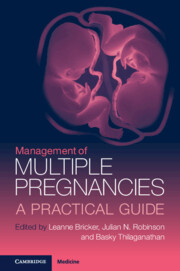Book contents
- Management of Multiple Pregnancies
- Management of Multiple Pregnancies
- Copyright page
- Contents
- Editors
- Contributors
- Chapter 1 Epidemiology of Multiple Pregnancy
- Chapter 2 Assisted Conception and Multiple Pregnancy
- Chapter 3 Zygosity, Chorionicity and Amnionicity
- Chapter 4 Multifetal Pregnancy Reduction
- Chapter 5 Gestational Dating in Multiple Pregnancy
- Chapter 6 Screening for Fetal Aneuploidy in Multiple Pregnancy
- Chapter 7 Screening for Fetal Abnormality in Multiple Pregnancy
- Chapter 8 Screening and Diagnosis of Complications of Shared Placentation
- Chapter 9 Invasive Prenatal Diagnosis in Multiple Pregnancy
- Chapter 10 Conjoined Twinning
- Chapter 11 Management of Discordant Fetal Anomaly
- Chapter 12 Single and Double Fetal Loss in Twin Pregnancy
- Chapter 13 Management of Twin–Twin Transfusion Syndrome
- Chapter 14 Management of Twin Anaemia-Polycythaemia Sequence
- Chapter 15 Management of Twin-Reversed Arterial Perfusion (TRAP) Sequence
- Chapter 16 Management of Fetal Growth Pathology in Multiple Pregnancy
- Chapter 17 Management of Monoamniotic Twins
- Chapter 18 Maternal Complications in Multiple Pregnancy
- Chapter 19 Risk Assessment and Screening for Preterm Birth in Multiple Pregnancy
- Chapter 20 Prevention of Preterm Birth in Multiple Pregnancies
- Chapter 21 Optimal Antenatal Care in Multiple Pregnancy
- Chapter 22 Triplet and Higher-Order Pregnancy
- Chapter 23 Timing of Delivery in Multiple Pregnancy
- Chapter 24 Mode of Delivery in Multiple Pregnancy
- Chapter 25 Practical Management of Vaginal Delivery in Multiple Pregnancy
- Chapter 26 Neonatal Care Aspects of Multiple Pregnancy
- Chapter 27 Lifestyle Considerations for Multiple Pregnancy
- Chapter 28 Emotional and Mental Well-Being in Multiple Pregnancy
- Chapter 29 New Frontiers in Multiple Pregnancy Management
- Chapter 30 Multiple Pregnancy Resources for Professionals and the Public
- Chapter 31 Obstetric Anaesthesia in Multiple Pregnancy
- Index
- Plate Section (PDF Only)
- References
Chapter 9 - Invasive Prenatal Diagnosis in Multiple Pregnancy
Published online by Cambridge University Press: 11 October 2022
- Management of Multiple Pregnancies
- Management of Multiple Pregnancies
- Copyright page
- Contents
- Editors
- Contributors
- Chapter 1 Epidemiology of Multiple Pregnancy
- Chapter 2 Assisted Conception and Multiple Pregnancy
- Chapter 3 Zygosity, Chorionicity and Amnionicity
- Chapter 4 Multifetal Pregnancy Reduction
- Chapter 5 Gestational Dating in Multiple Pregnancy
- Chapter 6 Screening for Fetal Aneuploidy in Multiple Pregnancy
- Chapter 7 Screening for Fetal Abnormality in Multiple Pregnancy
- Chapter 8 Screening and Diagnosis of Complications of Shared Placentation
- Chapter 9 Invasive Prenatal Diagnosis in Multiple Pregnancy
- Chapter 10 Conjoined Twinning
- Chapter 11 Management of Discordant Fetal Anomaly
- Chapter 12 Single and Double Fetal Loss in Twin Pregnancy
- Chapter 13 Management of Twin–Twin Transfusion Syndrome
- Chapter 14 Management of Twin Anaemia-Polycythaemia Sequence
- Chapter 15 Management of Twin-Reversed Arterial Perfusion (TRAP) Sequence
- Chapter 16 Management of Fetal Growth Pathology in Multiple Pregnancy
- Chapter 17 Management of Monoamniotic Twins
- Chapter 18 Maternal Complications in Multiple Pregnancy
- Chapter 19 Risk Assessment and Screening for Preterm Birth in Multiple Pregnancy
- Chapter 20 Prevention of Preterm Birth in Multiple Pregnancies
- Chapter 21 Optimal Antenatal Care in Multiple Pregnancy
- Chapter 22 Triplet and Higher-Order Pregnancy
- Chapter 23 Timing of Delivery in Multiple Pregnancy
- Chapter 24 Mode of Delivery in Multiple Pregnancy
- Chapter 25 Practical Management of Vaginal Delivery in Multiple Pregnancy
- Chapter 26 Neonatal Care Aspects of Multiple Pregnancy
- Chapter 27 Lifestyle Considerations for Multiple Pregnancy
- Chapter 28 Emotional and Mental Well-Being in Multiple Pregnancy
- Chapter 29 New Frontiers in Multiple Pregnancy Management
- Chapter 30 Multiple Pregnancy Resources for Professionals and the Public
- Chapter 31 Obstetric Anaesthesia in Multiple Pregnancy
- Index
- Plate Section (PDF Only)
- References
Summary
The prevalence of multiple pregnancies is increasing over the last few decades. This is due in part due to use of assisted reproductive techniques which are associated with a higher prevalence of multiple gestation compared to spontaneous conceptions. There is considerable evidence to suggest that combined screening for fetal aneuploidies is equally effective for twin pregnancies as it is in singletons. This along with a relatively higher rate of fetal defects requires accurate prenatal diagnosis. There is evidence from large cohort studies, systematic reviews and meta-analysis that the risk of procedure-related loss in singleton pregnancies is not significantly higher than the background rate of miscarriages. The number of studies examining the procedure-related loss in twin pregnancies following invasive procedures is fewer compared to singleton pregnancies. Although the background rate of pregnancy loss is higher in multiple pregnancies compared to singletons, there is evidence from recent systematic reviews and meta-analysis that the procedure-related loss following invasive procedures is not significantly higher compared to the background rate of loss in twin pregnancies. Invasive prenatal procedures in dichorionic and monochorionic multiple pregnancies have unique challenges including technical skill, rates of complications and sampling errors and therefore such procedures should be carried out by experienced operators in Fetal Medicine centres.
- Type
- Chapter
- Information
- Management of Multiple PregnanciesA Practical Guide, pp. 92 - 98Publisher: Cambridge University PressPrint publication year: 2022

